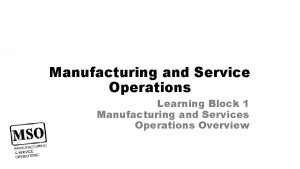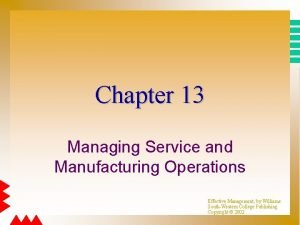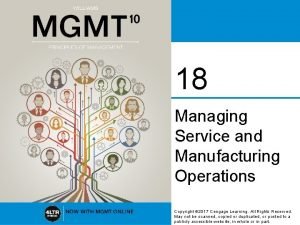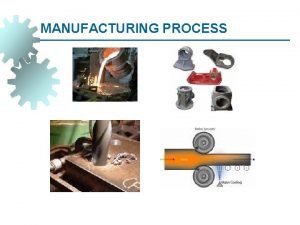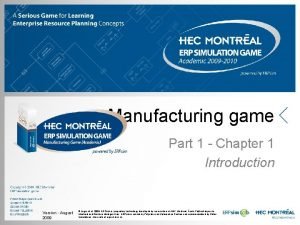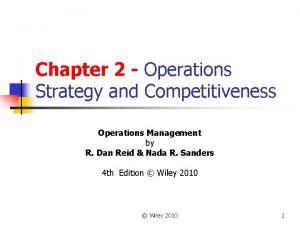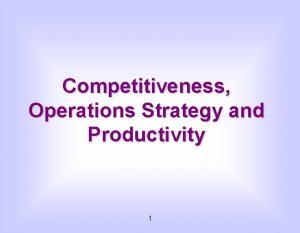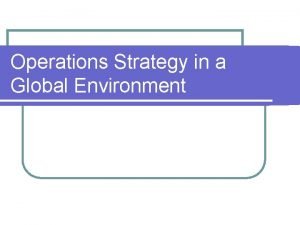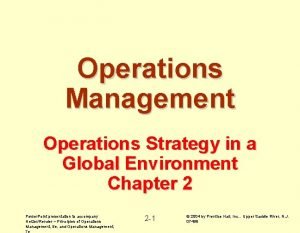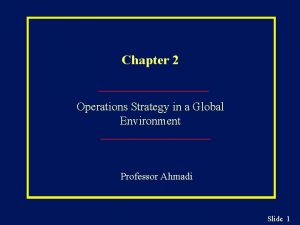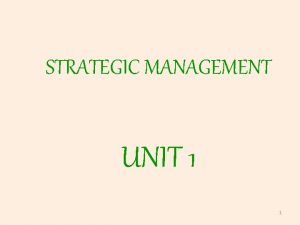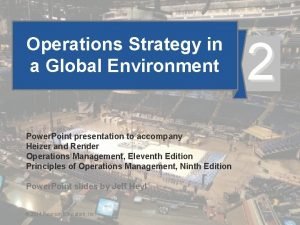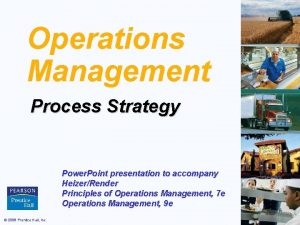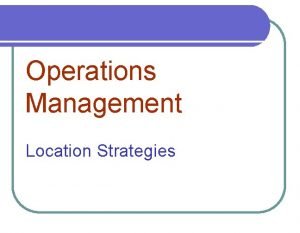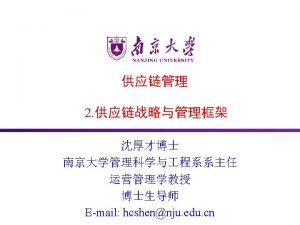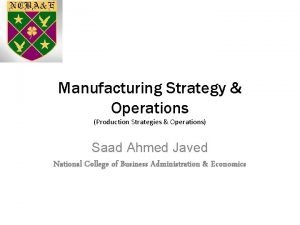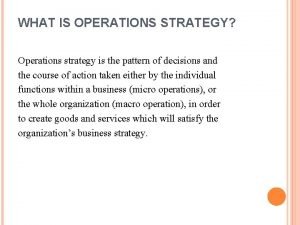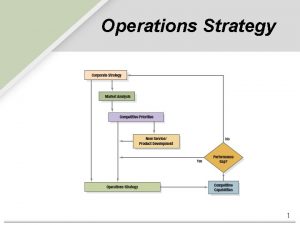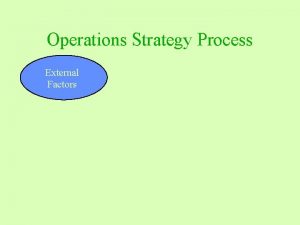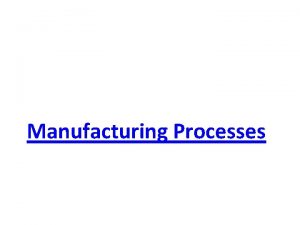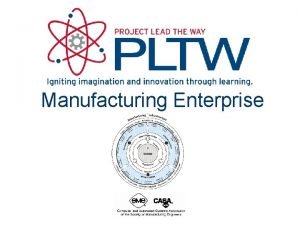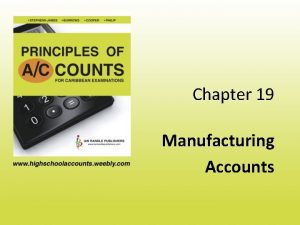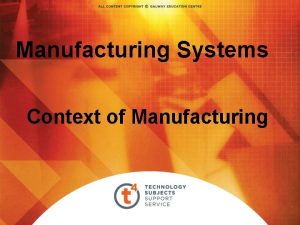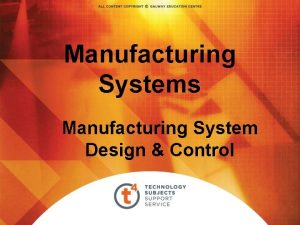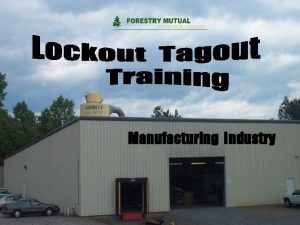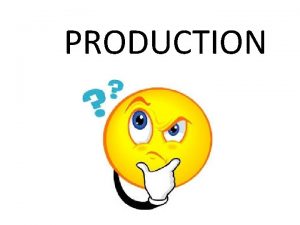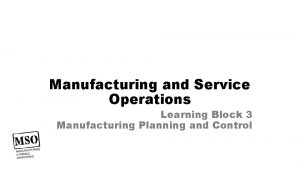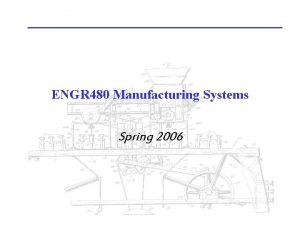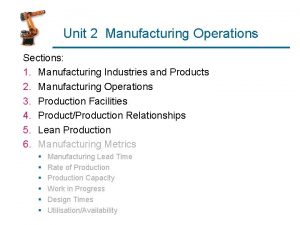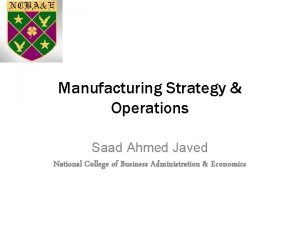Manufacturing and Operations Strategy How manufacturing and operations























- Slides: 23

Manufacturing and Operations Strategy How manufacturing and operations can be used for competitive advantage in today’s world 10/17/2021 1

The course focuses on five topics • • • Basic Principles Decision Category Framework Means of Competition New Imperatives of the 21 st Century Implementation 2

A COMPANY’S MANUFACTURING FUNCTION TYPICALLY IS EITHER A COMPETITIVE WEAPON OR A CORPORATE MILLSTONE. IT IS SELDOM NEUTRAL. YET, THE CONNECTION BETWEEN MANUFACTURING AND CORPORATE SUCCESS IS RARELY SEEN AS MORE THAN THE ACHIEVEMENT OF HIGH EFFICIENCY AND LOW COSTS. …WHAT APPEARS TO BE ROUTINE MANUFACTURING DECISIONS FREQUENTLY COME TO LIMIT THE CORPORATION’S STRATEGIC OPTIONS, BINDING IT WITH FACILITIES, EQUIPMENT, PERSONNEL, AND BASIC CONTROLS AND POLICIES TO A NONCOMPETITIVE POSTURE WHICH MAY TAKE YEARS TO TURN AROUND. WICKHAM SKINNER HBR, MAY-JUNE 1969 3

SHIP IT! 4

Typical Corporation Sales R&D Marketing Finance Corporate Plans Strategic Planning Manufacturing 5

The Corporate Strategic Planning Process Less Frequent than Annual Review Corporate Business 1 3 Functional Source: Fine and Hax Annual Review Strategy Formulation 2 Strategic Programming 6 4 5 Strategic and Operational Budgeting 9 7 12 Interactions Hierarchical Levels of Structural Planning Conditions 10 8 11 6

External Influences Industry Forces -Industry Attractiveness External Influences - Competitive Structure: Opportunities & Threats Goals Objectives Strategic Plan: Organization’s Gaining & Maintaining “Culture” Competitive Advantage - Capabilities: Sources of - Competitive strengths/weaknesses priorities Functional Strategies Mktg. Mfg. Finance Key Success Factors: Logistics - Internal Coherence - Inter-functional Coordination - Strategic Fit 7

The Similar Approach of Hoshin Management Environmental Change Long-term vision & plan Diagnosis by president Company’s mid-term plan Plan Do Hoshin & measurement plan deployment Annual hoshins Act Control by measurement Check Source: A New American TQM by Shiba, Graham, Walden, 1993 8

Capabilities Positioning Configuration Business Strategy Capabilities Cross-Functional Integration (Fit) Functional Strategies TD Manufacturing Strategy Structure Key Decision Areas Capacity Facilities Technology Vert. Int. Infrastructure Workforce Quality Prod. Plan Org. • Capabilities: Strategic Consequence of Functional Execution • New capabilities can form basis of new manufacturing strategy. • Cannot buy or easily copy capabilities that take a long time to develop. D. L. Barton “Core Competency and Core Rigidity” Prahalad and Hamel “The Core Competence of the Corporation” Hayes and Pisano “The New Manufacturing Strategy” Hayes and Upton “Operations-based Strategy” 9

Reasons for Inconsistent Manufacturing Structures 1. Manufacturing has a new manufacturing task but continues the old manufacturing policies and structure. 2. Managers in manufacturing have no clear, consistent definition or understanding of the manufacturing task facing the organization. 3. The manufacturing policies and the infrastructure being employed are inconsistent. Taken together, there is a distortion in coordination. 4. The organization lacks a focus. It is attempting to cover too many technologies or too many products and markets, too wide a range volume, and more than one manufacturing task. 10

Reasons for Inconsistent Manufacturing Structures (cont. ) 5. The organization has the wrong equipment & process technology for the present manufacturing task. 6. Selection of products and processes for each plant in a multi-plant setup results in mixing together, somewhat at random, a product organization, a process organization, and a volume-focused organization (or any two of the three) instead of focusing around one type of organization. 11

Hayes and Wheelright Stages 1. Minimize manufacturing’s negative potential: “Internally Neutral” 2. Achieve parity (neutrality) with competitors: “Externally Neutral” 3. Provide credible support to the business strategy: “Internally Supportive” 4. Pursue a manufacturing-based competitive advantage: “Externally Supportive” 12

The decision category approach examines manufacturing decision categories for consistency with strategic vision • Structural decisions – bricks and mortar – machinery • Infrastructure – people – systems – procedures • Fit with business, corporation and other functions 13

Major Manufacturing Decision Categories 1. FACILITIES • size • location • focus 2. CAPACITY • amount • timing • type 3. VERTICAL INTEGRATION AND PARTNER MANAGEMENT • direction • extent • interfaces • collaboration 4. PRODUCTION TECHNOLOGIES AND PROCESSES • equipment • automation • interconnectedness • scale • flexibility 5. WORK FORCE AND MANAGEMENT • wage policies • security • skill levels 6. LOGISTICS AND SUPPLY CHAIN • logistics facilities and methods • inventory policies • vendor coordination • production planning 7. ORGANIZATIONAL AND INCENTIVES • structure • reporting levels • degree of centralization • role of staff • control/reward systems • costing systems 8. BUSINESS PROCESSES: PRODUCT DEVELOPMENT, QUALITY INFRASTRUCTURE ETC. • interfaces and responsibilities • vendor development • monitoring and intervention 14

Facilities and Capacities Capacity Issues: - Does Capacity lead or follow Demand: - Capacity Decisions have long lead times and involve large increments Facility Issues: - Pure Space Needs - Geographic & Distribution Issues - Focus Issues - Corporate principles - Scale Issues - Means of Evaluation 15

Technology and the Manufacturing Process is a fundamental determinant of how a company competes - Processes have specific attributes that are appropriate for different products and life cycles - Any new process or technology will have a major effect on a business - No technology meets all needs - Products and businesses have life cycles that 16 change process needs

Process Productivity is Best Understood Through the Process-Product Matrix Products One of Kind Jumbled High Volume Job Not Productive Not Flexible Continuous Process Rigid 17

BASIC INFRASTURCTUAL QUESTIONS • • • Levels and strengths of Hierarchy Orientation and form of organization What do you measure most? Class culture Information and control systems Role of materials and logistics 18

The strategic mission matches the organization’s strengths to a limited set of external measures of performance Measures of Performance • OPERATIONS COSTS –unit costs –total (volume) costs –lifetime costs • DEPENDABILITY AND TIME –percentage of on-time shipments –response to results for info or changes –product and volume flexibility –delivery time • • QUALITY – return rate – product reliability and durability – cost and rate of field repairs INNOVATIVENESS – product innovativeness – time to market and development cycle 19

The Classic Plant Missions Mission Labor Low Unit Cost Facilities Specialized Materials planning machines linked and control by the time cycle High service Reserve machine Overtime and level capacity time Wide line Infrastructure Repetitive work Inventory management General purpose. Production machines and scheduling inventory of tools idle Changing assignments Custom service General purpose. Design to cost machines Reliance on workers’ skills Product Team Flexible general Design and 20

Linking Strategies to Missions Mission Investment Requirements Marketing Strategy Sales Low Unit Cost Automation Narrow line and conservative design Price competition High service level delivery Inventory and Image of flexible machines dependability Strategy Custom Reserve capacity Analysis of Ability to respond service Product Rapid customers’ needs Product New market Market leadership 21

Present Operations Policies Operations Unit Decision Category Description of Past Policy Strengths Weaknesses Production Technologies & Processes Capacity Workforce and Management 22

Present Operations Policies (cont’d. ) Operations Unit Decision Category Description of Past Policy Strengths Weaknesses Business Processes Facilities Vert. Int and Partner Management 23
 Manufacturing cost vs non manufacturing cost
Manufacturing cost vs non manufacturing cost Job costing vs process costing examples
Job costing vs process costing examples Uncontrollable cost example
Uncontrollable cost example Manufacturing cost vs non manufacturing cost
Manufacturing cost vs non manufacturing cost Additive manufacturing steps
Additive manufacturing steps Difference between manufacturing and service operations
Difference between manufacturing and service operations Managing service and manufacturing operations
Managing service and manufacturing operations Managing service and manufacturing operations
Managing service and manufacturing operations Classification of manufacturing processes
Classification of manufacturing processes Polyvalor
Polyvalor Operations strategy and competitiveness
Operations strategy and competitiveness Competitive operations strategy
Competitive operations strategy Scale based strategy
Scale based strategy How do you measure productivity
How do you measure productivity Operations strategy in a global environment
Operations strategy in a global environment The global environment and operations strategy
The global environment and operations strategy The global environment and operations strategy
The global environment and operations strategy Operations strategy in a global environment
Operations strategy in a global environment Corporate strategy and business strategy
Corporate strategy and business strategy Chase aggregate plan example
Chase aggregate plan example Characteristics of strategic management
Characteristics of strategic management Operations strategy in global environment
Operations strategy in global environment Process strategy
Process strategy Location operations management
Location operations management





